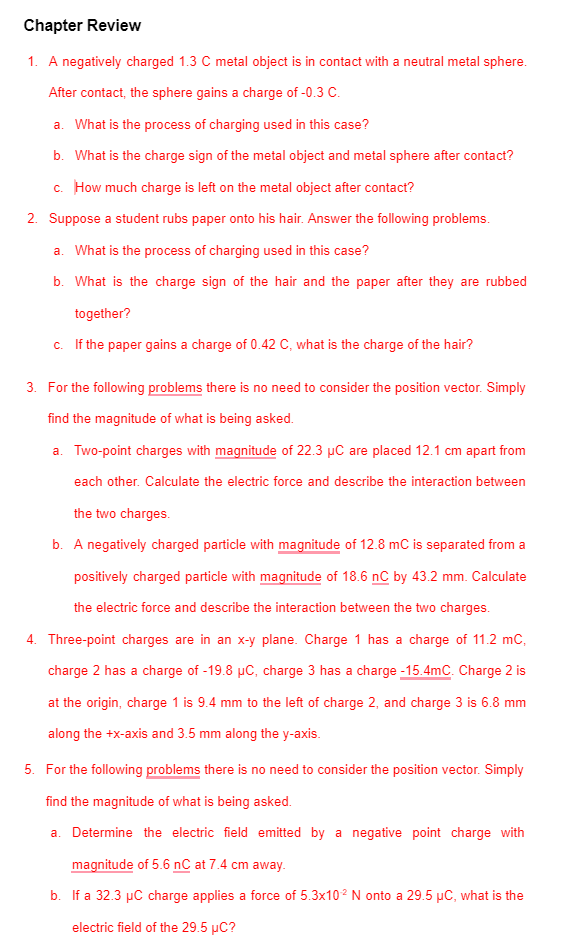1. A negatively charged 1.3 C metal object is in contact with a neutral metal sphere. After contact, the sphere gains a charge of -0.3 C. a. What is the process of charging used in this case? b. What is the charge sign of the metal object and metal sphere after contact? c. How much charge is left on the metal object after contact?
1. A negatively charged 1.3 C metal object is in contact with a neutral metal sphere. After contact, the sphere gains a charge of -0.3 C. a. What is the process of charging used in this case? b. What is the charge sign of the metal object and metal sphere after contact? c. How much charge is left on the metal object after contact?
Principles of Physics: A Calculus-Based Text
5th Edition
ISBN:9781133104261
Author:Raymond A. Serway, John W. Jewett
Publisher:Raymond A. Serway, John W. Jewett
Chapter19: Electric Forces And Electric Fields
Section: Chapter Questions
Problem 62P
Related questions
Question
answer 1

Transcribed Image Text:Chapter Review
1. A negatively charged 1.3 C metal object is in contact with a neutral metal sphere.
After contact, the sphere gains a charge of -0.3 C.
a. What is the process of charging used in this case?
b. What is the charge sign of the metal object and metal sphere after contact?
c. How much charge is left on the metal object after contact?
2. Suppose a student rubs paper onto his hair. Answer the following problems.
a. What is the process of charging used in this case?
b. What is the charge sign of the hair and the paper after they are rubbed
together?
c. If the paper gains a charge of 0.42 C, what is the charge of the hair?
3. For the following problems there is no need to consider the position vector. Simply
find the magnitude of what is being asked.
a. Two-point charges with magnitude of 22.3 µC are placed 12.1 cm apart from
each other. Calculate the electric force and describe the interaction between
the two charges.
b. A negatively charged particle with magnitude of 12.8 mC is separated from a
positively charged particle with magnitude of 18.6 nC by 43.2 mm. Calculate
the electric force and describe the interaction between the two charges.
4. Three-point charges are in an x-y plane. Charge 1 has a charge of 11.2 mC,
charge 2 has a charge of -19.8 µC, charge 3 has a charge -15.4mC. Charge 2 is
at the origin, charge 1 is 9.4 mm to the left of charge 2, and charge 3 is 6.8 mm
along the +x-axis and 3.5 mm along the y-axis.
5. For the following problems there is no need to consider the position vector. Simply
find the magnitude of what is being asked.
a. Determine the electric field emitted by a negative point charge with
magnitude of 5.6 nC at 7.4 cm away.
b. If a 32.3 µC charge applies a force of 5.3x102 N onto a 29.5 µC, what is the
electric field of the 29.5 µC?
Expert Solution
This question has been solved!
Explore an expertly crafted, step-by-step solution for a thorough understanding of key concepts.
This is a popular solution!
Trending now
This is a popular solution!
Step by step
Solved in 2 steps with 2 images

Knowledge Booster
Learn more about
Need a deep-dive on the concept behind this application? Look no further. Learn more about this topic, physics and related others by exploring similar questions and additional content below.Recommended textbooks for you

Principles of Physics: A Calculus-Based Text
Physics
ISBN:
9781133104261
Author:
Raymond A. Serway, John W. Jewett
Publisher:
Cengage Learning

Physics for Scientists and Engineers
Physics
ISBN:
9781337553278
Author:
Raymond A. Serway, John W. Jewett
Publisher:
Cengage Learning

Physics for Scientists and Engineers with Modern …
Physics
ISBN:
9781337553292
Author:
Raymond A. Serway, John W. Jewett
Publisher:
Cengage Learning

Principles of Physics: A Calculus-Based Text
Physics
ISBN:
9781133104261
Author:
Raymond A. Serway, John W. Jewett
Publisher:
Cengage Learning

Physics for Scientists and Engineers
Physics
ISBN:
9781337553278
Author:
Raymond A. Serway, John W. Jewett
Publisher:
Cengage Learning

Physics for Scientists and Engineers with Modern …
Physics
ISBN:
9781337553292
Author:
Raymond A. Serway, John W. Jewett
Publisher:
Cengage Learning

College Physics
Physics
ISBN:
9781938168000
Author:
Paul Peter Urone, Roger Hinrichs
Publisher:
OpenStax College

College Physics
Physics
ISBN:
9781285737027
Author:
Raymond A. Serway, Chris Vuille
Publisher:
Cengage Learning

College Physics
Physics
ISBN:
9781305952300
Author:
Raymond A. Serway, Chris Vuille
Publisher:
Cengage Learning